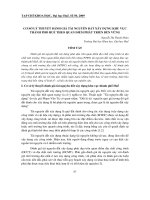Bài giảng y học chứng cứ bài 5 chứng cứ của các nghiên cứu chuẩn đoán, trình bày cơ sở chuẩn đoán, đánh giá các nghiên cứu chuẩn đoán, sai lầm trong chuẩn đoán, thiết kế cơ bản của một nghiên cứu chuẩn đoán chính xác
Bạn đang xem bản rút gọn của tài liệu. Xem và tải ngay bản đầy đủ của tài liệu tại đây (10.31 MB, 53 trang )
Bài 5: CHỨNG CỨ CỦA CÁC
NGHIÊN CỨU CHẨN ĐOÁN
Matthew J. Thompson
p
GP & Senior Clinical Scientist
Department of Primary Health Care
University of Oxford
Nội
ộ dung
g bài học
ọ
Cơ sở chẩn đoán
Đánh giá các nghiên cứu chẩn
đoán
Chẩn đoán là gì?
Làm tăng độ chắc
ắ chắn
ắ việc
mắc hay không mắc bệnh
Tính trầm trọng của bệnh
Giám sát theo dỏi diển biến
lâm sàng
Đánh g
giá tiên lượng-nguy
ợ g g y cơ/
các giai đoạn của bệnh
Kế hoạch điều trị
Kịp lúc
Knottnerus, BMJ 2002
Sai lầm trong chẩn đoán
Hầu hết các sai lầm trong chẩn đoán là
cognitive errors:
Conditions of uncertainty
Thinking is pressured
Shortcuts are used
(Ann Croskerry
Croskerry. Ann Emerg Med 2003)
Những sai lầm trong chẩn đoán (Diagnostic errors The next frontier for Patient Safety. Newman-Toker, JAMA 2009)
40,000-80,000
40
000 80 000 US h
hospital
it l d
deaths
th ffrom
misdiagnosis per year
Adverse events, negligence cases, serious
disability more likely to be related to
misdiagnosis than drug errors
Diagnostic reasoning
Diagnostic strategies particularly important
where patients present with variety of conditions
and p
possible diagnoses.
g
Diagnostic reasoning
Thí dụ: nguyên nhân của ho là gì?
Comprehensive history
examination
diagnosis
final diagnosis
differential
Diagnostic reasoning
For example, what causes cough?
Comprehensi e history…examination…differential
Comprehensive
histor e amination differential
diagnosis…final diagnosis
Cardiac failure
failure, left sided , Chronic obstructive pulmonary disease , Lung abscess
Pulmonary alveolar proteinosis, Wegener's granulomatosis, Bronchiectasis
Pneumonia, Atypical pneumonia, Pulmonary hypertension
Measles, Oropharyngeal cancer, Goodpasture's syndrome
Pulmonary oedema, Pulmonary embolism, Mycobacterium tuberculosis
Foreign body in respiratory tract, Diffuse panbronchiolitis, Bronchogenic carcinoma
Broncholithiasis, Pulmonary fibrosis, Pneumocystis carinii
Captopril, Whooping cough, Fasciola hepatica
Gastroesophageal reflux, Schistosoma haematobium, Visceral leishmaniasis
Enalapril, Pharyngeal pouch, Suppurative otitis media
Upper respiratory tract infection, Arnold's nerve cough syndrome, Allergic bronchopulmonary aspergillosis
Chlorine gas, Amyloidosis, Cyclophosphamide
Tropical pulmonary eosinophilia, Simple pulmonary eosinophilia, Sulphur dioxide
Tracheolaryngobronchitis Extrinsic allergic alveolitis
Tracheolaryngobronchitis,
alveolitis, Laryngitis
Fibrosing alveolitis, cryptogenic, Toluene di-isocyanate, Coal worker's pneumoconiosis
Lisinopril, Functional disorders, Nitrogen dioxide, Fentanyl
Asthma, Omapatrilat, Sinusitis
Gabapentin, Cilazapril
……diagnostic
di
ti reasoning
i
Đánh g
giá test chẩn đoán
1. Kết quả có giá trị?
2 Kết quảả gì?
2.
ì?
3. Kết quả đó có giúp
chăm sóc
ó bệnh
ệ nhân
â
không?
Thiết kế cơ bản của một nghiên cứu chẩn
đoán chính xác
Hàng loạt bệnh nhân
Chỉ số của test
Tham chiếu tiêu chuẩn vàng (
gold”) standard
Xếp loại bệnh nhân (Blinded
cross--classification)
cross
l
ifi ti )
Validity
y of diagnostic
g
studies
1. Was an appropriate
pp p
spectrum
p
of p
patients
included?
2. Were all patients subjected to the gold standard?
3. Was there an independent, blind or objective
comparison
p
with the g
gold standard?
1. Was an appropriate
pp p
spectrum
p
of
patients included? Spectrum bias
Selected Patients
Index test
Reference standard
Blinded cross
cross--classification
1. Was an appropriate spectrum of
patients included? Spectrum bias
You want to find out how good chest X
rays are for diagnosing pneumonia in the
E
Emergency
D
Department
t
t
Best = all patients presenting with
diffi lt b
difficulty
breathing
thi gett a chest
h tX
X-ray
Spectrum bias = only those patients in
whom
h
you really
ll suspectt pneumonia
i gett a
chest X ray
2. Were all patients subjected to the gold
standard?
t d d? Verification
V ifi ti ((work-up)
k ) bi
bias
Series of patients
Index test
Reference standard
Blinded cross
cross--classification
2. W
2
Were all
ll patients
ti t subjected
bj t d tto th
the gold
ld
standard? Verification (work-up) bias
You want to find out how good is exercise
ECG ((“treadmill test”)) for identifying
y gp
patients
with angina
The gold standard is angiography
Best = all patients get angiography
V ifi ti ((work-up
Verification
k
bi ) = only
bias)
l patients
ti t
who have a positive exercise ECG get
angiography
angiograph
3. Was there an independent, blind or
objective
bj ti comparison
i
with
ith th
the gold
ld
standard? Observer bias
Series of patients
Index test
Reference standard
Unblinded cross
cross--classification
3. Was there an independent, blind or
j
comparison
p
with the g
gold
objective
standard? Observer bias
You want to find out how good is exercise
ECG for identifying
y gp
patients with angina
g
All patients get the gold standard
(angiography)
Observer bias = the Cardiologist who
does the angiography knows what the
exercise ECG showed (not blinded)
Incorporation Bias
Series of patients
Index test
Reference standard….. includes parts of
Index test
Unblinded cross
cross--classification
Differential Reference Bias
Series of patients
Index test
Ref. Std A
Ref. Std. B
Blinded cross
cross--classification
Validity
y of diagnostic
g
studies
1. Was an appropriate
pp p
spectrum
p
of p
patients
included?
2. Were all patients subjected to the Gold
Standard?
3. Was there an independent,
p
, blind or objective
j
comparison with the Gold Standard?
Appraising
pp
g diagnostic
g
tests
1. Are the results valid?
2 What
2.
Wh t are th
the results?
lt ?
3. Will they help me
look after my patients?
Sensitivity, specificity,
Sensitivity
specificity
positive & negative
predictive values,
likelihood ratios
…aaarrrggh!!
2 by
y 2 table
+
+
Test
-
Disease
-
2 by
y 2 table
+
Disease
-
+
a
b
-
c
d
Test
2 by
y 2 table
+
+
Test
-
Disease
-
a
b
True
positives
False
positives
c
d
False
negatives
i
True
negatives
i
2 by
y 2 table: sensitivity
y
+
+
Disease
-
a
Proportion
p
of p
people
p
with the disease who
have a positive test
result
result.
c
.…a highly sensitive test
will not miss many
people
Test
-
Sensitivity = a / a + c









